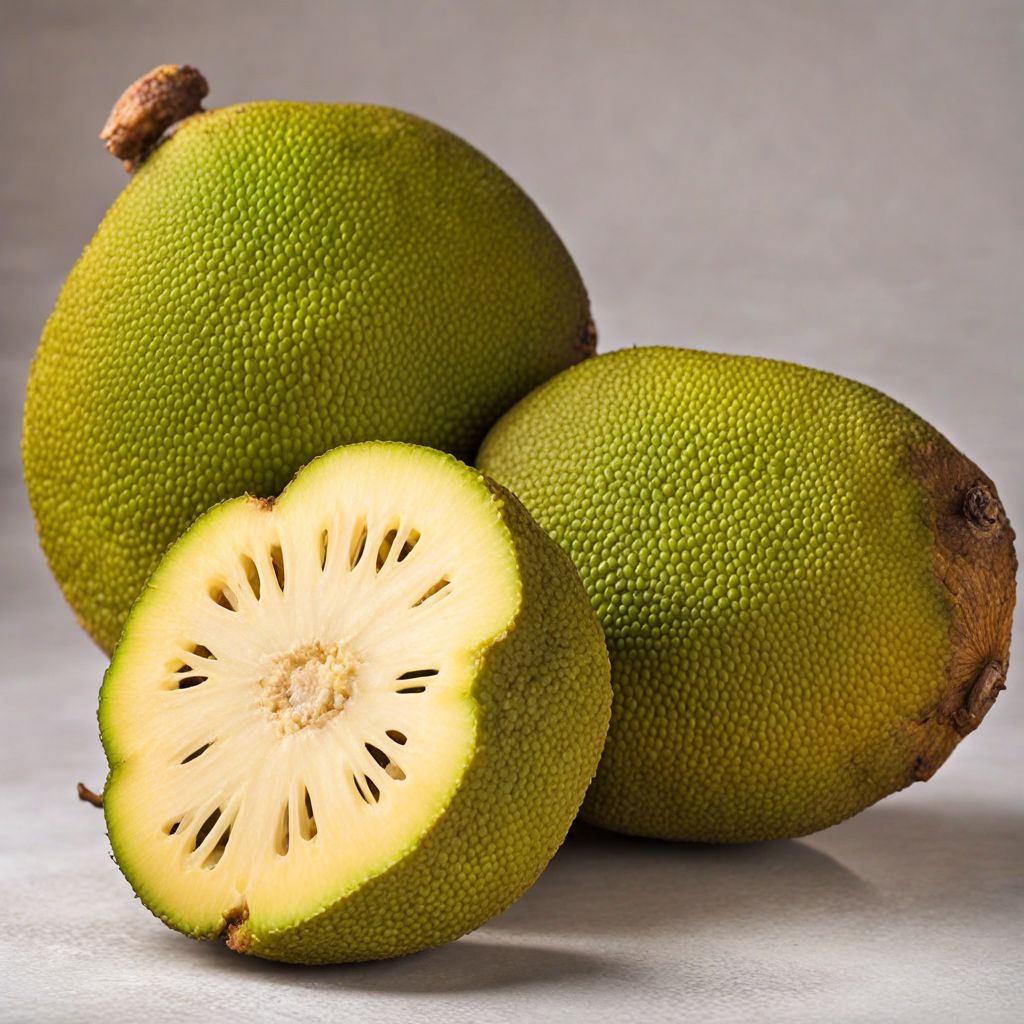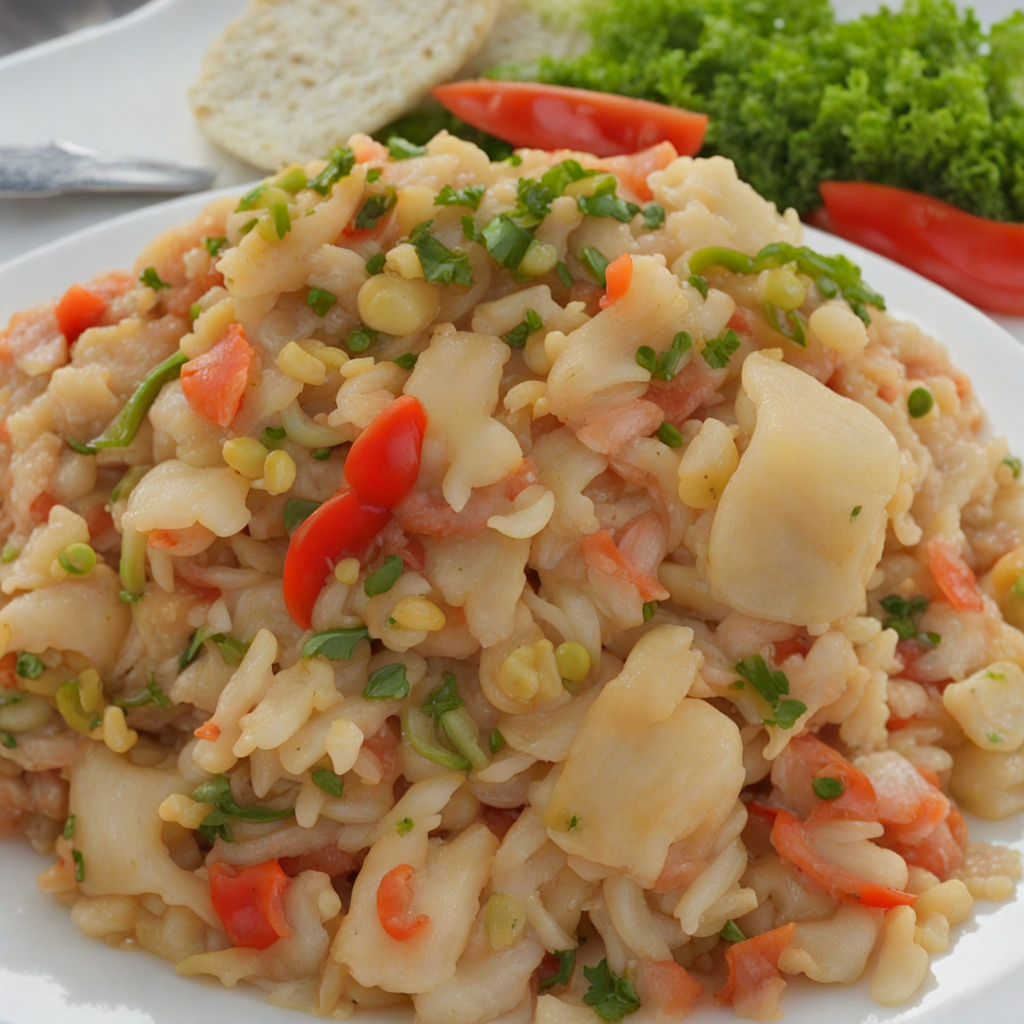Breadfruit
Breadfruit, a tropical delight native to the Caribbean, particularly Dominica, is a versatile fruit that has captured the hearts and palates of many. Its exterior resembles that of a jackfruit, with a rough, green skin, while the flesh inside is starchy and creamy, much like a potato. When cooked, breadfruit has a mild, nutty flavor that can be likened to a combination of potato and artichoke. This unique taste makes it an excellent base for a variety of dishes, from savory to sweet, providing a delightful canvas for culinary creativity. In Dominica, breadfruit is often prepared in numerous ways, showcasing its adaptability. It can be roasted, boiled, or fried, and is commonly served as a side dish or incorporated into stews and curries. One popular local preparation is 'breadfruit pie,' where the fruit is mashed and mixed with spices, cheese, and sometimes meat, creating a comforting and hearty meal. Additionally, breadfruit chips have gained popularity, offering a crunchy snack that retains the fruit's subtle flavor while adding a satisfying texture. The beauty of breadfruit lies not only in its taste but also in its nutritional profile. It is rich in fiber, vitamins, and minerals, making it a healthy alternative to traditional starches. As it gains recognition globally, breadfruit’s culinary potential continues to expand, inviting food enthusiasts to explore its various preparations. Whether you choose to enjoy it simply boiled with a sprinkle of salt or dressed up in a gourmet dish, breadfruit promises a unique and satisfying gastronomic experience that reflects the vibrant culture of Dominica.
How It Became This Dish
The Journey of Breadfruit: A Cultural and Culinary Treasure of Dominica #### Origins and Introduction to the Caribbean Breadfruit (Artocarpus altilis) is a tropical fruit native to the Indo-Malay region and was first domesticated in New Guinea. Its journey from the lush forests of Southeast Asia to the Caribbean islands is a tale of exploration, colonization, and cultural exchange. The fruit was introduced to the Caribbean in the late 18th century as part of a British initiative to provide a cheap food source for enslaved laborers working in the sugar plantations. In 1787, Captain William Bligh, known for his infamous mutiny on the HMS Bounty, undertook a mission to transport breadfruit seedlings from Tahiti to the West Indies. The British hoped that breadfruit would thrive in the Caribbean's tropical climate and serve as an inexpensive staple for the enslaved population. After Bligh's arduous journey, the seedlings were successfully planted in Saint Vincent and later spread to other islands, including Dominica. #### The Role of Breadfruit in Dominica In Dominica, breadfruit quickly became an integral part of the island's agricultural landscape and culinary traditions. The fruit is easily cultivated and grows abundantly in the region's fertile volcanic soil. Locally known as "fig," breadfruit is cherished for its versatility and nutritional value. It is a starchy fruit, rich in carbohydrates, vitamins, and minerals, making it an excellent food source for the island's inhabitants. The cultural significance of breadfruit in Dominica extends beyond its nutritional benefits. It has become a symbol of resilience and resourcefulness among the people of the island. Historically, during times of economic hardship or food scarcity, breadfruit has provided sustenance for generations of Dominicans. The fruit's ability to thrive in various conditions has solidified its status as a staple food in the local diet. #### Culinary Traditions and Uses Breadfruit is a culinary chameleon, adapting to numerous cooking methods and flavor profiles. When harvested young, the fruit is firm and can be sliced and boiled, mashed, or fried. The taste is often likened to that of potato, making it an ideal substitute in many savory dishes. As it ripens, the flesh becomes softer and sweeter, allowing it to be used in desserts. Dominican cuisine features a variety of traditional breadfruit dishes, such as "breadfruit and saltfish," where boiled breadfruit is paired with salted cod and seasoned vegetables. Another popular dish is "breadfruit pie," a hearty casserole that showcases the fruit's savory qualities. Additionally, grilled or roasted breadfruit is a beloved street food, often enjoyed with a spicy dipping sauce. The preparation of breadfruit is often a communal affair, with families and friends gathering to share recipes and techniques. Festivals and cultural events frequently highlight breadfruit as a key ingredient, promoting not only its culinary versatility but also its significance in the community. #### Cultural Significance and Symbolism Beyond its culinary uses, breadfruit holds a deeper cultural significance in Dominica. It symbolizes the island's history, heritage, and identity. The fruit is often featured in local folklore and tales, emphasizing its role in the survival of the island's ancestors. The communal nature of breadfruit preparation reflects the importance of community bonds in Dominican culture. In recent years, as Dominica has embraced its rich cultural heritage, breadfruit has become a focal point for promoting local agriculture and cuisine. Initiatives aimed at preserving traditional farming methods and culinary practices have reinvigorated interest in this historical fruit and its role in the island's identity. #### Challenges and Resilience Despite its historical significance, breadfruit has faced challenges over the years, including the impact of climate change and the encroachment of invasive species. Farmers have had to adapt their practices to ensure the sustainability of this vital crop. However, the resilience of the Dominican people is evident in their commitment to preserving breadfruit cultivation and usage. Local organizations and agricultural programs have emerged to educate farmers on sustainable practices and promote the cultivation of breadfruit. Efforts to revive traditional recipes and cooking methods have also gained momentum, raising awareness of the fruit's significance and nutritional benefits among younger generations. #### Breadfruit in a Global Context Today, breadfruit is gaining recognition beyond the shores of Dominica. As global interest in plant-based diets and sustainable agriculture grows, breadfruit is emerging as a viable alternative to traditional staples in various culinary traditions worldwide. Its potential as a food source is being explored in health-conscious communities, particularly in urban areas where food deserts exist. In Dominica, initiatives aimed at exporting breadfruit products are underway, allowing the island to showcase its culinary heritage on a global stage. The development of value-added products, such as breadfruit chips, flour, and purees, is helping to expand the fruit's marketability while preserving its cultural significance. #### Conclusion The history of breadfruit in Dominica is a rich tapestry interwoven with themes of survival, community, and culinary heritage. From its introduction by Captain Bligh to its current status as a beloved staple, breadfruit has transcended its role as mere food to become a symbol of the island's identity. As Dominica continues to navigate the challenges of the modern world, breadfruit remains a testament to the resilience, creativity, and cultural richness of its people. This extraordinary fruit not only nourishes the body but also nourishes the spirit, reminding the people of Dominica of their enduring connection to their past and the promise of their future.
You may like
Discover local flavors from Dominica







